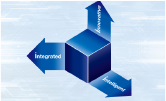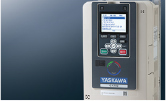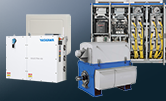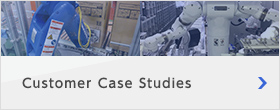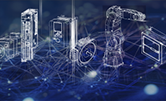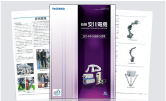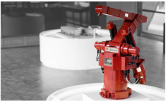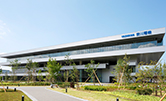Technical Progress in 2019
Preface
Representative Director, President
Hiroshi Ogasawara
In the economic situation surrounding Yaskawa in 2019, there were some markets which remained strong, including for products for automobiles in Japan, and oil and gas related markets in the United States. However, the background of the prolonged trade friction between the U.S. and China led to a postponement of investment in the semiconductor market overall and a deceleration of the automobile related markets. As a result of this, a cautious attitude to equipment investment was seen globally and the situation continued to be severe. On the other hand, in the area of technology development, dramatic change in the global management environment has now become normal. This includes the technical advances represented by AI and IoT, which are pushing reforms in the way businesses operate in the FA market.
In this situation, Yaskawa has defined the fundamental policy of the “2025 Vision” long-term business plan for the company to be, “Contribute to solving customers’ management issues in addition to creating new added value to society, through evolution of core businesses, and expansion into new fields by applying mechatronics technology.” We have also redefined our vision as the “Automation and optimization of factories through i3-Mechatronics (i cube mechatronics)” and “New fields of mechatronics application for sustainable social development.” We started our new medium-term business plan “Challenge 25” in 2019 as the second stage of the “2025 Vision”. We have defined the fundamental policy for activities in “Challenge 25” as “Transform Business Model through i3-Mechatronics,” “Maximize Profitability in the Growing “Robotics” Business Field” and “Expand New Domains by Strengthening Resources through “Selection and Concentration””. In the “Transform Business Model through i3-Mechatronics” , we are further accelerating the transformation to a business model based on the unique Yaskawa Group solution concept “i3-Mechatronics” and aim to enhance the functions of technology development, production and sales. As for the enhancement of technology development, we will newly consolidate functions by establishing the “Yaskawa Technology Center (tentative name)” and strengthen our integrated efforts from the development of elemental technologies to trial manufacture for mass production. Based on the “i3-Mechatronics” we will develop and market technologies and products that meet customer needs in a timely manner. In the “Maximize Profitability in the Growing “Robotics” Business Field,” we will accelerate our efforts to expand the Chinese and Asian markets centered on the “3C (Computer, Communication, Consumer)” areas. Also, in the automobile-related market where the Yaskawa Group has competitive edge, we will strengthen our efforts with finished vehicles and parts manufacturers and provide new solutions and robots. Furthermore, in the semiconductor production equipment market, which is expected to grow significantly in the future, we aim to strengthen our product lineup and improve productivity. In the “Expand New Domains by Strengthening Resources through “Selection and Concentration”, we will concentrate its resources on application fields where it can utilize its strengths of mechatronics technology to develop new fields and markets (including in energy saving, food and agriculture, and clean power in particular).
The technical development in each individual division field during 2019 was as follows.
In the motion control division, we developed the new-generation open field network MECHATROLINK-4 and advanced its application to controller and servo drive products. We also launched the GA500 general-purpose compact high-performance AC drive and expanded the lineup in our new series of AC drives. In the robotics division, in initiatives for the realization of “i3-Mechatronics,” we further advanced the YASKAWA Cockpit data management system and also developed various applications. In the system engineering division, we promoted research for sewerage operation control support techniques using AI. In the clean power division, we launched the XGI1500 solar inverter. In research and development, we are working on the development of various technologies for the realization of “i3-Mechatronics,” including robot controllers, environmental vision systems and sensorless techniques using AI.
In order to construct a coherent research and development system from foundational research to trial manufacture for mass production , Yaskawa is working on the opening of the “Yaskawa Technology Center (tentative name)” (planned for completion in FY2020). In the past, we have been developed individually technologies such as “servos,” “AC drives” and “robots” for the best performance in the world. In addition to this, we will deepen the use of data in the connections between each of these technologies and integrate the technical ability in the Yaskawa Group in order to propose problem-solving methods using data to our customers. Furthermore, we will promote open innovation centerd on industry-academia collaboration and expand to new fields where we can make a contribution, such as agriculture, logistics, medical care and welfare. Please have great expectations for our solutions as Yaskawa continues to take on the challenges of new business areas from now on.
[Motion Control Division] AC drive product enhancement
The environment surrounding the industrial world has changed greatly in recent years. This includes a reinforcement of energy efficiency regulations globally. There has also been increasing attention paid to productivity enhancement using IoT, including with Industry 4.0. In order to be compatible with these changing customer needs, we are working on the development of compact and high performance products that can maximize machine performance, and products for specific applications.
(1) Yaskawa launched the GA500 general-purpose compact high-performance AC drive, which is in the smallest class of such products globally. This product is designed for use in a wide range of applications such as general industrial machines and equipment. This product is equipped with innovative PM motor control and contributes to energy saving. It is also able to contribute to improved production efficiency and support the IoT with “Failure prediction diagnostics” that realize machines and equipment that do not stop.
(2) For the HVAC market, the HV600 AC drive was launched as a product with reinforced performance for harmonization with the power supply environment. The HV600 has an EMC filter and DC reactor mounted as standard in all capacity bands and handles the power supply harmonics. As dust- and drip-proof performance, it is also compatible with the protection class IP55.
[Motion Control Division] Major PR and exhibitions
Yaskawa booth and Exhibits at IIFES2019
(1) At the IIFES2019 (Innovative Industry Fair for E x E Solutions, November 27-29, 2019, Tokyo Big Sight), Yaskawa exhibited under the theme of “Advanced i3-Mechatronics (i cube mechatronics) solving the issues of manufacturing sites.” The exhibits included introductions to servos and AC drives in five different areas such as i3-Mechatronics demonstrations and the energy saving area. In particular, the i3-Mechatronics demonstrations included presentations of the links between the new concept controller and YCP (Note). Through the linking, not only is it possible to conduct the centralized control and visualization of data for the entire cell on the same time base, it is also possible to provide feedback on the optimum control to the cell in real time based on the data accumulated. This demonstration gathered a lot of attention from the visitors.
Note: YCP is the abbreviation of YASKAWA Cockpit (the digital data management software platform developed by Yaskawa).
Yaskawa booth at FOOMA JAPAN 2019
(2) At FOOMA JAPAN 2019 (International Food Machinery & Technology Exhibition 2019, July 9-12, 2019, Tokyo Big Sight), Yaskawa exhibited under the theme of “A ‘Food’ revolution – Food and agriculture performed by robots -.” The exhibits introduced cases of i3-Mechatronics use (MP3000 series machine controller & Σ-7 series AC servo drive, and failure prediction diagnostics using an AC drive) and attracted the attention of a great number of visitors.
Yaskawa booth at the SMART FACTORY Expo
(3) At the SMART FACTORY Expo (January 16-18, 2019, Tokyo Big Sight), Yaskawa exhibited under the main theme of “i3-Mechatronics to realize smart factories.” The exhibits were mostly actual examples from the Yaskawa Solution Factory. These well-received exhibits introduced example applications of i3-Mechatronics and the effects of its operation.
[Robotics Division] Market changes and Yaskawa initiatives
Manufacturing industry equipment investment has been postponed in both Japan and overseas as a result of the slowdown in international trade due to the effects of Brexit, the trade friction between the U.S. and China and other factors. These factors have led to a sense of uncertainty in the industrial robot market. However, the expectations for robots are growing even greater than before, as the decrease in the labor force population and the diversification of demand have increased the needs for automation, and also technical progress such as AI and IoT has led companies to seek the advantages of digitizing equipment.
In order to respond to these needs, Yaskawa has worked to reinforce solution proposal capabilities and is proposing the “i3-Mechatronics” digital data solution concept that links the virtual and the real with all-Yaskawa component solutions. In addition to working to enhance the product lineup, Yaskawa is also accelerating development of the “YRM controller (tentative name)” to be the core system performing the integrated control of the robots and equipment in a cell and synchronizing all of their data.
In other areas, Yaskawa is working to reinforce development and production capabilities and to accelerate the launching of new products to respond to the expanding automation needs in the Chinese and Asian 3C (Computer, Communication and Consumer) markets, the global automobile market (for finished vehicles and parts) and the semiconductor manufacturing equipment market.
Advances in production systems through i3-Mechatronics
– YRM controller(tentative name)
[Robotics Division] Development and production capability reinforcement
For development capabilities, in order to increase the market competitiveness of Yaskawa as a robot manufacturer, efforts are being made to strengthen technology development capabilities globally (in Japan, China, Europe, America, etc.), and to accelerate elemental technology development for robot automation. In the area of digital data management, in addition to the YRM controller (tentative name), other development in progress includes advancing YCP to accumulate and analyze workplace data to realize more intelligent production workplaces, and the cell simulator engineering tool for cells. Yaskawa is also accelerating demonstration testing development for the practical application of AI solutions.
In production capabilities, in addition to the production plants in Fukuoka Prefecture (Kitakyushu City and Nakama City) and in Jiangsu Province in China (Changzhou City), a new production base was established in Kočevje City, Slovenia (YASKAWA Europe Robotics d.o.o.) to respond to the increased demand for robots in Europe from now on. The aim is to achieve a synergistic effect with the optimal production location in the three bases in Japan, China and Europe, and this has established a global production system that will be able to respond to the increasing demand and changes in the market from now on.
YASKAWA Europe Robotics d.o.o.
[Robotics Division] New product launches
New products are being launched successively to develop new markets. For handling applications, this included the launch of the multipurpose MOTOMAN-GP20HL with improved environmental resistance to contribute to automation in a wide range of fields. There were also the launched of the MOTOMAN-SG400 and -SG650 compact four-axis scara robots. In the human collaborative field, the scope of application was expanded with the launch of the MOTOMAN-HC10DT and -HC20DT (dustproof and drip-proof specifications) with improved environmental resistance and transportable mass and the MOTOMAN-HC10DTF (food specifications). Efforts were also made for the realization of i3-Mechatronics with the development of YCP analysis, monitoring and planning functions using digital data.
[Robotics Division] Exhibition
Yaskawa booth at the International Robot Exhibition 2019
At the International Robot Exhibition 2019 (December 18-21, 2019, Tokyo Big Sight), Yaskawa exhibited solutions using “All-Yaskawa” components under the theme of “Smart manufacturing realized by advances in i3-Mechatronics.” This included digital data management (big data/AI) and items such as human collaborative robots and other robots, servos and motion controllers. As a demonstration of the embodiment of the theme, the exhibits included a demonstration achieving optimal manufacturing appropriate for changes in the situation with digital data solutions linking the virtual and the real.
[System Engineering Division] Steel and industry systems
The market trends for system electrical items are greatly affected by the capitial investment by each company in the manufacturing industry. Over the past few years, the situation has been driven by the Chinese economy and has remained comparatively stable. However, the deceleration in the Chinese economy is becoming evident and the future is becoming slightly more difficult to predict.
On the other hand, for the Japanese steel industry, where reorganization is accelerating, it was a difficult year due to the continuing rise in the price of the iron ore used as a raw material, and also due to operation shutdowns due to natural disasters and facility fires.
Despite this business environment, investment was executed according to plan for themes such as safety and security, environmental load improvement, production efficiency improvement and work-style reforms. Yaskawa worked on many projects for aged facility renewal and function improvement renewal, including a project for the new installation of a large-scale iron and steel system.
The boom associated with Industry 4.0, IoT and AI has settled down and we have now entered the aspect of practical application to actual equipment and processes. Furthermore, there are expectations that the practical application of the 5G high-speed communications standard being adapted to the industrial field will contribute to an acceleration of the visualization of various different information and to productivity enhancement.
[System Engineering Division] Social systems
The sewage related budget for FY2019 was around the same as that in FY2018 and it was expected that the volume of orders for electrical installations would be on the same scale as in FY2018. However, the reduction in the number of employees engaged in the work and their increasing age has led to a serious shortage of supervising engineers for the sewerage operation and securing (training) engineers is becoming an issue. In addition, there has been an acceleration of public-private partnership action for disaster prevention and disaster effect reduction as a result of the “National Resilience Plan” of the government in response to the large-scale natural disasters occurring in recent years.
In response to this market situation, Yaskawa performed research on sewerage operation control support technology using AI to realize operator support with the passing on of the expertise of veteran employees, and on the provision of new systems that are easier to use and highly reliable to customers.
Example aeration air flow prediction results for treatment site A System 1
[System Engineering Division] Environmental energy
The power generation capacity of renewable energy around the world is expected to expand by 50% over the next five years.
In the wind power generation market, the installation of off-shore wind turbines is expanding, particularly in Europe. The competition in the development of large-capacity types exceeding 10 MW is accelerating and the planning of off-shore wind power is also accelerating and expanding in the Asian market. There are also construction plans proceeding for SEP vessels (Self-Elevating Platform vessels) to support off-shore wind turbine construction.
In the solar power generation market, in the U.S., the introduction of Power Purchase Agreements (PPA) by private companies has expanded. In Japan, there has been an acceleration of the introduction of Third Party Ownership (TPO) for housing and there has also been more active PPA adoption. There has also been an increasing trend towards the expanded adoption of self-consumption types and regional consumption types, including for use during disasters.
In response to these changes in the market, Yaskawa has worked to accelerate global development, particularly at business bases in the areas of demand (Europe and the U.S.).
[Research and Development] Exhibition at Robot Industry Matching Fair in Kitakyushu 2019
Robot Industry Matching Fair in Kitakyushu 2019
Yaskawa booth
Robot Industry Matching Fair in Kitakyushu 2019
Compact high-torque actuator (Demonstration machine)
At the Robot Industry Matching Fair in Kitakyushu 2019 (June 19-21, 2019, West Japan General Exhibition Center), Yaskawa exhibited the compact high-torque actuator for medical care and welfare devices.
The compact high-torque actuator was developed in joint research with JAXA (Japan Aerospace Exploration Agency). It can output high torque of 110 N-m and above with a light weight and flat configuration (Mass 894 g, thickness 38.4 mm). A slotless compact DC motor was newly developed to achieve the light weight and flat configuration. Also, to achieve higher torque, planetary gears and hypoid gears were combined for a higher reduction ratio and a mechanism was created to drive these with two compact DC motors.
The compact high-torque actuator has a light weight and flat configuration and a high torque output, so it is ideal for assist devices for medical care and welfare applications. A demonstration device simulating an assist device was exhibited at the matching fair and the thoughts and opinions of more than 400 visitors were obtained over the three days.
[Research and Development] FY2019 Kyushu Region Invention Award
Kyushu Region Invention Award
Batteryless motor encoder
The “Batteryless motor encoder (Patented)” was awarded the Fukuoka Prefecture Governor’s Award at the Kyushu Region Invention Award held on November 8, 2019.
This invention relates a batteryless encoder to detect the multiple rotation of a motor shaft, even when there is no battery when the power supply is off. The switching of the flux density caused by the magnet arrangement on the shaft end is taken out as an induced voltage by a special magnetic sensor which has the longer direction as the easy direction of magnetization. With this invention, even when the power supply is in the OFF condition, the multiple rotation of the motor shaft is counted and retained.
The merit of this invention is that a thin profile was achieved by having the magnetic circuit so that the easy direction of magnetization of the magnetic materials and the magnetization direction of the magnets arranged on the shaft end are in the direction along the plane orthogonal to the center line of rotation of the shaft.
The motor equipped with encoder that requires no battery which is realized in this invention is sold as an optional specification for the Σ-7 series AC servo motors produced by Yaskawa and has gained popularity among the customers.
[Research and Development] Receipt of Excellent Paper Award from the Technical Committee on Mechatronics Control of the IEEJ
Technical Committee on Mechatronics Control Award
The awards ceremony of the Technical Committee on Mechatronics Control of the IEEJ was held on January 10th, 2020. The paper “Simultaneous optimization of orders and parameters in cascade position control system” was awarded the Excellent Paper Award.
This technology realizes automatic adjustment of orders and parameters of a position controller in the software installed on a servo driver, in accordance with the user requirements and the characteristics of the machine driven by the servo motor.
The purpose of this research is to provide our customers easy-to-use products that enables us to automate the adjustment work before production line operation. We plan to achieve the automatic adjustment function by cooperating with the Σ-7 mechanical analysis function.
In addition, this research was one of the outcomes of joint research with the Hori Fujimoto Lab at the University of Tokyo.
[Technical Paper] GA500 General-purpose Compact High-Performance AC Drive
The industrial sector is currently experiencing great change, including with high efficiency regulations to suppress the power consumption of motors and the increasing interest in productivity enhancement through the use of the IoT, including in Industry 4.0. In this situation, the customers have a wide variety of issues and needs in each separate application.
In order to respond to these needs, Yaskawa has renewed the previous AC drive series under the concepts of being “flexible,” “easy” and “sustainable.” This has included the launch of general-purpose industrial use products that are optimal for general industrial machines and equipment, and products to provide added value with the optimal application specific products for each region and market. Following on from the GA700 high-performance AC drive for general-purpose industrial use, and the CR700 AC drive for cranes, Yaskawa has now launched the GA500 general-purpose compact high-performance AC drive as the third product in this new series. The GA500 is the successor model to the V1000 compact vector control AC drive for general industrial use.
In this paper the development background, concept, merits and specifications of the GA500 are described.
[Technical Paper] Digital Data Management System Embodying i3-Mechatronics
– Development of YASKAWA Cockpit and Add-on Applications –
Yaskawa has developed the YASKAWA Cockpit (hereinafter called, “YCP”) data management system as a step towards the realization of the i3-Mechatronics (i cube mechatronics) solution concept. The data necessary is collected from devices connected to the YCP and accumulated in a database by using a data collection app that is executed as an add-on application. Users provided with a WebAPI as the interface for this database access can use this WebAPI to build their own original application software to match their particular needs. General-purpose add-on applications for use in manufacturing workplaces have been prepared in advance in the YCP. Furthermore, in addition to the add-on applications for data collection when connected to Yaskawa products, there are also add-on applications provided for data collection when connected to programmable logic controllers and machine tools produced by other companies.
In this paper the merits of the YCP and the functions of the add-on applications are described.
[Technical Paper] Use of AI to Estimate the Grinding Condition from Control Torque
The autonomy of industrial robots will become an important element from now on in order to further raise productivity in the manufacturing field. This also applies to processing work and assembly work, where there are requirements for robots to autonomously execute the optimal operation for the state of the target of that work. The main method for judging the situation is to equip the robot with sensors, but the issues for this include the high costs and concerns about sensor failure. In response to this, we considered a method to estimate the work state from just the operation data from each axis of the robot, without using sensors. In this method, the control torque data when the robot performs the work is collected. The difference to the estimated work torque data is then used as the input in machine learning to generate a model estimating the work state. It can be expected that this method will make it possible for the robot to autonomously execute the appropriate operation to suit the state of the target of the work, without attaching sensors.
In this evaluation, this sensorless work state estimation method was applied to the grinding work for weld beads. In this paper the outline of that evaluation, the evaluation results and the outlook for the future are described.
 Region
Region



 Principles & vision
Principles & vision
 Procurement
Procurement
 Sustainability for the Yaskawa Group
Sustainability for the Yaskawa Group
 Customer satisfaction
Customer satisfaction
 Supply chain
Supply chain
 Social contribution
Social contribution
 Compliance & risk management
Compliance & risk management



